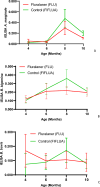Enzootic stability of tick fever in Holstein calves grazing in a tropical region, subjected to strategic cattle tick control with fluralaner
- PMID: 38461304
- PMCID: PMC10924980
- DOI: 10.1186/s13071-024-06212-w
Enzootic stability of tick fever in Holstein calves grazing in a tropical region, subjected to strategic cattle tick control with fluralaner
Abstract
Background: In 2022, fluralaner was launched on the market for use in the control of the cattle tick Rhipicephalus microplus after showing 100% efficacy in registration trials against the causative agents of cattle tick fever (TFAs). The aim of the present study was to determine whether a strategic control regimen against R. microplus using fluralaner (FLU) in Holstein calves grazing in a tropical region would alter the enzootic stability status of cattle tick fever, triggering outbreaks in these animals up to 22 months age.
Methods: In this study, a group of calves treated with FLU was compared with a control group treated with the regimen currently being used on the farm, which consisted of the fipronil + fluazuron formulation (FIFLUA). In the first experiment, the efficacy of the FIFLUA pour-on formulation was evaluated in a field study. In the second experiment, which lasted 550 days, two experimental groups (n = 30/group) of Holstein calves naturally infested with R. microplus were analyzed. Calves aged 4 to 10 months received either a specific treatment regimen with FLU (experimental group) or FIFLUA (control group). During this period, tick counts, animal weight measurement, feces collection (to determine eggs and oocysts per gram of feces), tick fever monitoring, blood smears (to ascertain enzootic stability of the herd), PCR testing for TFAs and serology (indirect enzyme-linked immunosorbent assay [iELISA]) were performed. All calves were evaluated for signs of tick fever between ages 11 and 22 months.
Results: FIFLUA showed an acaricidal efficacy of > 90% from post-treatment days 14 to 35. Regarding treatments against the TFAs, the average number of treatments was similar between groups, but animals treated with FLU had a smaller reduction in packed cell volume on some of the evaluation dates of the second and third treatment against TFAs. In calves aged 10 months in the FLU group, B. bovis was not detected by PCR (0/15 samples), 40% of the samples had antibody titers and 33% (10/30) of the samples had positive blood smears. Regarding B. bigemina, > 86% of the samples in both groups tested positive for B. bigemina DNA and antibodies; there was no difference in the antibody titers between the groups. There were no clinical cases of cattle tick fever in calves aged 11 to 22 months.
Conclusions: In comparison with the control treatment, the strategic control regimen against R. microplus with FLU that was implemented in the present study did not negatively affect the enzootic stability status of A. marginale and B. bigemina in the herd up to 22 months of age. The enzootic stability status of B. bovis was not reached by either group. These results likely represent a characteristic of the local tick population, so further studies should be performed.
Keywords: Rhipicephalus microplus; Anaplasmosis; Babesiosis; Isoxazoline.
© 2024. The Author(s).
Conflict of interest statement
DCR, TS and ST are employees of MSD/Merck Animal Health. The authors declare no competing interests.
Figures



Similar articles
-
Tick fever agents in Holstein calves grazing in a tropical region: predisposing factors, impact on milk production, productivity, and role of Rhipicephalus microplus in epidemiology.Vet Parasitol. 2024 Oct;331:110290. doi: 10.1016/j.vetpar.2024.110290. Epub 2024 Aug 15. Vet Parasitol. 2024. PMID: 39153286
-
Rhipicephalus microplus, babesiosis and anaplasmosis in Uruguay: current situation and control or elimination programs on farms.Exp Appl Acarol. 2019 Aug;78(4):579-593. doi: 10.1007/s10493-019-00405-0. Epub 2019 Jul 27. Exp Appl Acarol. 2019. PMID: 31352648
-
Prevalence, risk factors, and genetic diversity of veterinary important tick-borne pathogens in cattle from Rhipicephalus microplus-invaded and non-invaded areas of Benin.Ticks Tick Borne Dis. 2018 Mar;9(3):450-464. doi: 10.1016/j.ttbdis.2017.12.015. Epub 2017 Dec 28. Ticks Tick Borne Dis. 2018. PMID: 29307783
-
A review of the history of research and control of Rhipicephalus (Boophilus) microplus, babesiosis and anaplasmosis in Uruguay.Exp Appl Acarol. 2018 Aug;75(4):383-398. doi: 10.1007/s10493-018-0278-3. Epub 2018 Aug 6. Exp Appl Acarol. 2018. PMID: 30083875 Review.
-
Productivity and health effects of anaplasmosis and babesiosis on Bos indicus cattle and their crosses, and the effects of differing intensity of tick control in Australia.Vet Parasitol. 2008 Aug 1;155(1-2):1-9. doi: 10.1016/j.vetpar.2008.03.022. Epub 2008 Apr 7. Vet Parasitol. 2008. PMID: 18472219 Review.
Cited by
-
A systematic review of fluralaner as a treatment for ectoparasitic infections in mammalian species.PeerJ. 2025 Mar 12;13:e18882. doi: 10.7717/peerj.18882. eCollection 2025. PeerJ. 2025. PMID: 40093406 Free PMC article.
-
Acaricidal efficacy of fluralaner against Rhipicephalus microplus ticks under laboratory and field conditions in Brazil.Parasit Vectors. 2025 Apr 28;18(1):161. doi: 10.1186/s13071-025-06775-2. Parasit Vectors. 2025. PMID: 40296035 Free PMC article.
References
-
- Machado RZ, da Silva JB, André MR, Gonçalves LR, Matos CA, Obregón D. Outbreak of anaplasmosis associated with the presence of different Anaplasma marginale strains in dairy cattle in the states of São Paulo and Goiás. Rev Bras Parasitol Vet. 2015;24:438–446. doi: 10.1590/S1984-29612015078. - DOI - PubMed
-
- Nicaretta JE, de Melo Junior RD, Naves RB, de Morais IML, Salvador VF, Leal LLLL, et al. Selective versus strategic control against Rhipicephalus microplus in cattle: a comparative analysis of efficacy, animal health, productivity, cost, and resistance management. Vet Parasitol. 2023;321:109999. doi: 10.1016/j.vetpar.2023.109999. - DOI - PubMed
-
- Nicaretta JE, Zapa DMB, Couto LFM, Heller LM, Cavalcante AS de A, Cruvinel LB, et al. Rhipicephalus microplus seasonal dynamic in a Cerrado biome, Brazil: An update data considering the global warming. Vet Parasitol. 2021;296:109506. - PubMed
-
- Gomes LVC, Lopes WDZ, Teixeira WFP, Maciel WG, Cruz BC, Felippelli G, et al. Population dynamics and evaluation of the partial selective treatment of crossbreed steers naturally infested with Rhipicephalus (Boophilus) microplus in a herd from the state of Minas Gerais in Brazil. Vet Parasitol. 2016;220:72–76. doi: 10.1016/j.vetpar.2016.02.029. - DOI - PubMed
MeSH terms
Substances
LinkOut - more resources
Full Text Sources

